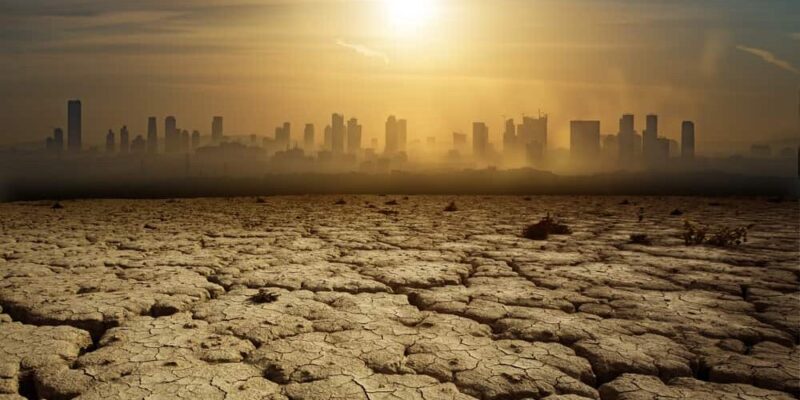We explain what global warming is, what its causes and consequences are. Also, its characteristics and how to reverse the damage.
What is global warming?
Global warming is the increase in the average temperature of the Earth caused by an environmental imbalance . It is a phenomenon produced by the excessive actions of the human being , caused by practices such as the abuse of natural resources and excess waste that pollute and interrupt the natural development of the ecosystem .This phenomenon has been studied from the pre-industrial period onwards, starting in 1900, and an increase in the average temperature of the planet was detected that continues to rise and in an increasingly accelerated way, especially from the decade of 1980 .
The main cause of global warming is the imbalance in the greenhouse effect due to the increase in polluting gases, such as carbon dioxide and methane, which are released into the atmosphere indiscriminately.
It is called the greenhouse to the process in which part of the energy from the Sun that reaches Earth is reflected back into space, while another part is absorbed by gases in the atmosphere that retain as heat and do not allow go back to space. In this way, the gases in the atmosphere maintain the average temperature of the planet that is suitable for life.
The greenhouse effect is a natural process. Its imbalance is caused by the intensity of human activity which, through the exploitation of natural resources and the elimination of waste, causes a saturation of polluting gases in the atmosphere that destabilizes its natural order.
The greater the release of polluting gases into the atmosphere, the greater the retention of solar energy, which is why the intensity of the heat increases.
Global warming should not be confused with climate change, which is the alteration of the meteorological conditions that characterize each weather station. Climate change is one of the consequences of global warming of the planet. There are different causes and effects that trigger the same problem: the indiscriminate actions of the human species.
Characteristics of global warming
Global warming is characterized by:
- The increase in the average temperature of the planet due to the accumulation of polluting gases in the atmosphere. Currently, it has exceeded tolerable limit levels.
- The consequences it triggers, such as the greenhouse effect and climate change .
- For the most part, the damages it triggers are irreversible , such as the extinction of animal and plant species due to the alteration of their habitat.
- The imbalance of ecosystems caused by the indiscriminate activity of the human species.
- Abuse that makes the human being of natural resources caused by the lack of protection of soil , the pollution of the air , of the water and the extinction of non - renewable resources .
Causes of global warming
 The factors that contribute to global warming are diverse, among the main ones are:
The factors that contribute to global warming are diverse, among the main ones are:
- The indiscriminate felling of trees . The forests serve several functions vital to maintain the balance of the ecosystem. One of the main ones is that they absorb gases that cause the greenhouse effect, such as carbon dioxide, and release oxygen . By exterminating more and more forests and increasing the polluting gases released into the atmosphere, the problem worsens. Forests also protect soils in cases of natural overflow of water courses, floods or heavy rains. Trees retain water helping the soil not to erode. The falling leaves protect the soil from the intense heat, which is another factor that can alter the nutrients of the soil and also serve as organic matter that decomposes and allows it to be nourished.
- Monoculture type agriculture. Native plantations maintain the balance of flora and fauna. Instead, massive agricultural production systems wipe out flora, fauna, and nutrients from the soil. Monoculture consists of vast tracts of land destined to plant a single plant species. The seed of that vegetable is genetically manipulatedto tolerate climatic conditions and fertilizers or poisons that are then sprayed at harvest to exterminate possible pests. Nitrous oxide is a gas derived from fertilizers that is polluting, both for the soil and the atmosphere, and alters the greenhouse effect. Monoculture is carried out systematically, without allowing the soil to settle and recompose after harvest, which that destroys the nutrients in the soil. As a consequence, the native flora is altered, which causes the disappearance of populations or even plant and animal species that no longer have their native food.
- The increase in methane gas released into the atmosphere . The various natural sources of methane gas, such as the decomposition of organic matter and animal manure, contribute to the balance of the greenhouse effect. However, human activity through the extraction of fossil fuels such as oil, monoculture-type agriculture such as rice and the large concentration of animals for livestock exploitation release immeasurable amounts of methane gas. agricultural-livestock is recognized as one of the most polluting due to methane gas emissions and waste in waterways. In addition, it implies the exploitation of non-renewable natural resources, such as water and fertile soils, vital for the entire world population .
- The system of production and consumption. Factories and industries require a large amount of raw materials that, in many cases, come from non-renewable natural resources. During the manufacturing process, gases and highly polluting waste are usually released into the air or waters that impact the environment and all the beings that inhabit it, not only the manufacturing processit is highly polluting. Once the final products are generated, a new polluting circuit begins: with the transfer of the products, their presentation at various points of sale and, once acquired and consumed by people, their packaging and packaging accessories are discarded, instead of be recycled. Those wrappings can last for centuries on the planet before disintegrating.
- The burning of fossil fuels . Fuels, such as coal, gasoline, and compressed natural gas, come from the extraction of petroleum , a non-renewable natural resource that took millions of years to form. Both the extraction of oil and its transfer and subsequent treatment in derivatives generate pollutionAccidental or negligent spills can occur during the drilling, extraction and transfer of oil, which are highly polluting. In addition, the combustion of petroleum products releases various gases, such as carbon dioxide and carbon monoxide, which increase the greenhouse effect and pollute the rest of the environment. This type of combustion is generated by cars, airplanes, ships and other means of transport, in addition to the various industries and factories during their manufacturing process.
- Lack of environmental conservation . The conservation and promotion of caring for the environment is a vital issue that must be addressed from policies of all nations and in formal education. By educating on the importance of awareness in the care of natural resources, especially non-renewable ones, and the dimension of the impact reached by human actions, less harmful customs for the environment can be adopted. moral, legal, political and, mainly, vital issue for all living beings on the planet. Without the balance of ecosystems, human beings cannot live, although the planet will continue to exist, in another way. The human being is one more member of planet Earth and needs all biodiversity for its existence.
Consequences of global warming
 Among the main consequences of global warming are:
Among the main consequences of global warming are:
- The greenhouse effect . It is an increase in polluting gases that are released into the atmosphere and that are capable of retaining solar energy to generate heat. The higher the concentration of gases, the higher the retention of solar energy and the higher the heat.
- Climate change. It is the alteration of meteorological patterns that usually define regional climates . The increase in temperatures affects the vegetation and the animals that depend on it, it evaporates a greater concentration of water causing droughts and, at the same time, more intense rains or floods due to the increase in water vapor in the hydrological cycle .
- The melting of the glaciers. Large masses of ice help maintain the planet's average temperature. Global warming causes an increase in the temperature of the oceans that accelerates the melting of glaciers. As a consequence, large floods are generated caused by the rise in sea level and the water vapor that is released into the atmosphere and triggers more intense rains.
- Air pollution . It is the presence of toxic gases that, in too much concentration, becomes harmful to the air that living beings breathe. In addition to polluting the air, the water vapor that is later condensed and returned to the earth in the form of rain also concentrates the polluting substances that end up impacting on the ground and on water bodies.
- The extinction of animal and vegetable species. The accelerated alteration of the balance of soil, air and water or the annihilation of populations leads to an imbalance in which the biosphere is altered. The conditions are no longer suitable for native vegetation, so the animals stop having food sources and, because these changes are so intense and rapid, they do not allow enough time for many of the species to adapt, so they become extinct.
How to reverse the damage caused?

Both from environmental policies around the world and from the actions of each person in their day to day, all this is necessary to stop the increase in global warming and its serious consequences.
Among the main positive impact actions that everyone can implement, the following stand out:
- Use low consumption light bulbs .
- Unplug electrical appliances when they are not in use, such as the cell phone charger that continues to consume energy.
- Reduce and moderate the use of heaters and air conditioners.
- Use public transport or the bicycle instead of the car.
- Always moderate the use of water , both when washing dishes, hands or taking a shower.
- Separate garbage into organic materials for compost and inorganic materials or waste that can be recycled.
- Reduce the use of plastic bags for biodegradable or reusable materials, such as washable cloth bags.
- Reduce the consumption of meat and derivatives for plant foods.
- Research and know where consumer products come from and how they were made. Choose alternatives that do not include toxic components or that endanger natural resources.
- Implement energy and industrial policies free of oil and its derivatives, which are replaced by renewable and clean energy sources.
There is an increasing human population that carries a greater demand to supply its level of consumption and with a smaller amount of finite natural resources and biodiversity.
The paradigm shift is essential and urgent to reverse this problem. Fortunately, there is no single solution, but there are so many actions that can be done to improve and achieve a new balance for life on the planet as people in the world.
The above content published at Collaborative Research Group is for informational and educational purposes only and has been developed by referring reliable sources and recommendations from technology experts. We do not have any contact with official entities nor do we intend to replace the information that they emit.
MA student of the TransAtlantic Masters program at UNC-Chapel Hill. Political Science with a focus on European Studies. Expressed ideas are open to revision. He not only covers Technical articles but also has skills in the fields of SEO, graphics, web development and coding. .
Leave a reply
Your email address will not be published. Required fields are marked *Recent post

Sport: What Is It, Types, Risks, Features, Characteristics and Examples

Dogs: Emergence, Features, Characteristics, Feeding and Breeds

Story: Definition, Elements, Structure, Features and Characteristics

